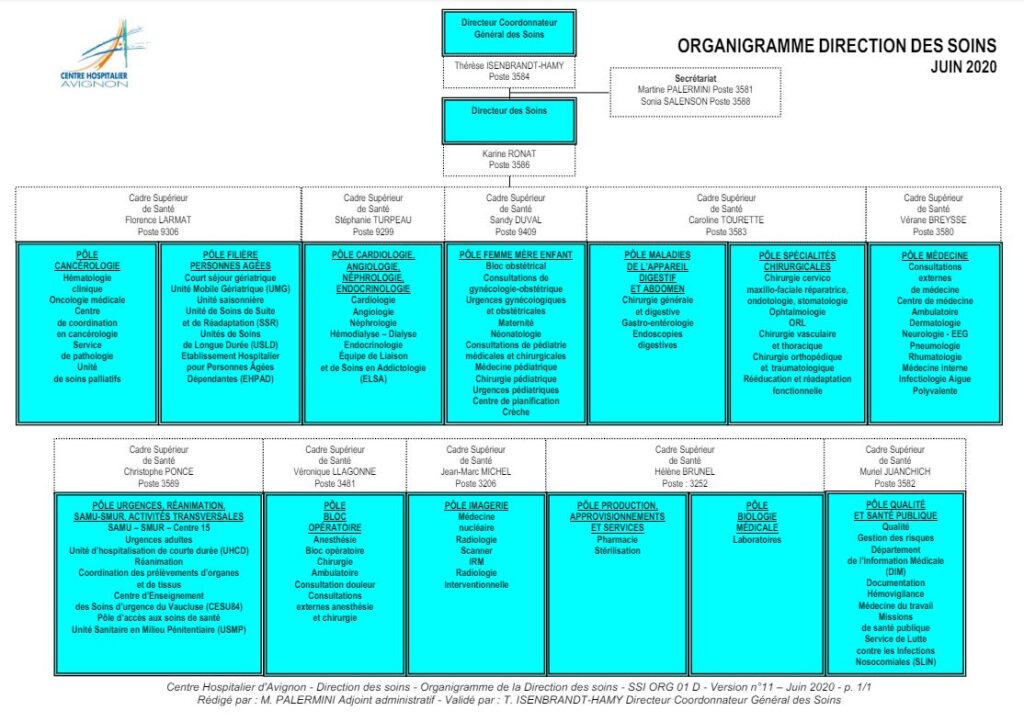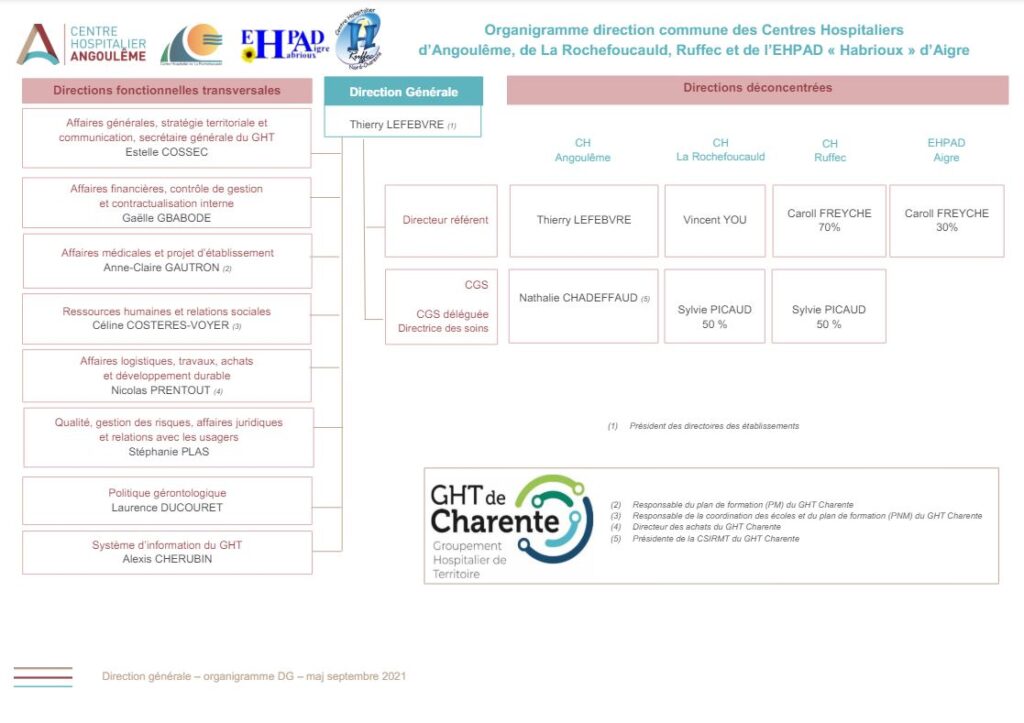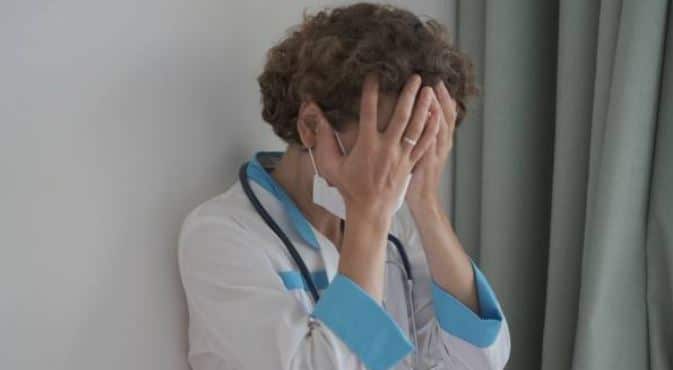
A well-structured organization is essential for efficient plant management. A clear, detailed organization chart defines roles, responsibilities and hierarchical relationships, promoting coordination and communication between the various departments.
1. The key organizational departments of a hospital or university hospital

General management of the hospital
The General Manager (GM) is responsible for the overall strategic direction of the hospital. He defines overall strategy, and makes major decisions on resource management, policies and hospital orientations. He ensures that the hospital runs smoothly.
At Lille University Hospital, for example, the DG recently oversaw the setting up of a new clinical research center to improve health services and available treatments.
Board of Directors
Made up of members of management, staff representatives and external stakeholders, the Board of Directors oversees the hospital’s major orientations, ensures compliance with legal and ethical obligations, and ensures good governance of the establishment.
Hospital Medical Department
Medical Director: The Medical Director supervises medical services, ensures quality of care and oversees the integration of innovative medical practices. At Toulouse University Hospital, the Medical Director has introduced telemedicine practices to improve access to specialist care in rural areas.
Department heads: Each department (surgery, internal medicine, pediatrics, etc.) is headed by a department head who manages day-to-day operations, personnel and resources specific to their field.
The head of the orthopedic surgery department atHôpital Saint-Antoine, for example, manages surgeon schedules, patient waiting lists and equipment requirements.
Hospital Nursing Department
Director of Nursing: The Director of Nursing coordinates nursing services and ensures the quality of patient care. He or she is responsible for nursing staff management, ongoing training and compliance with care protocols.
AtHôpital Européen Georges-Pompidou, the Director of Nursing recently set up a mentoring program for new recruits.
Head Nurses: Supervise nursing teams in different departments, provide ongoing training and ensure compliance with care protocols. For example, the head nurse of the cardiology department at Hôpital Cochin coordinates care and implements new treatment protocols.
Hospital administrative and financial management
Administrative and Financial Director: Manages the hospital’s finances, human resources and general administration to ensure efficient and sustainable management of resources. At Grenoble University Hospital, the Administrative and Financial Director recently led a project to reduce energy costs, resulting in substantial savings.
Administrative Services Managers: They handle admissions, patient file management, billing and relations with insurance companies and mutual insurers. At Hôpital de la Pitié-Salpêtrière, administrative services managers have improved the admissions process to reduce patient waiting times.
Hospital Technical and Logistics Services Department
Technical Services Manager: The Technical Services Manager oversees maintenance, security and logistics services. He is responsible for infrastructure maintenance, the smooth operation of medical equipment and the safety of premises and facilities. It is in this department in particular that safety issues are addressed.
AtHôpital Necker-Enfants Malades, the Technical Services Manager recently managed a major renovation project to modernize hospital facilities.
Technical Managers: Manage infrastructure, medical equipment and cleaning services, ensuring the quality of facilities and equipment. They ensure that all diagnostic equipment is regularly maintained and updated.
2. Hospital organization: allocation of responsibilities and team coordination

Decision-making and responsibilities within the hospital
Decisions are taken at different levels, depending on the nature and impact of the issues at stake. Strategic decisions are taken by senior management, while operational decisions are managed by department heads and service managers.
Management decisions
General management defines the hospital’s strategic orientations, allocates budgetary resources and makes major decisions concerning the future of the establishment.
For example, it can decide on the introduction of new medical technologies, the opening of new specialized services, or the establishment of partnerships with other healthcare institutions. General management plays a key role in defining long-term objectives and managing the human and financial resources needed to achieve them.
Decisions by department heads
Department heads manage the day-to-day activities of their department, supervise the medical staff and make the operational decisions needed to keep the department running smoothly.
For example, a surgical department head decides on the organization of operating theatres, the distribution of tasks among surgeons and the management of surgical emergencies. They play a crucial role in implementing the strategies defined by general management at operational level.
Responsibilities of Department Managers
Department managers are responsible for the day-to-day management of their department, supervising teams, implementing protocols and procedures, and making operational decisions within their area of responsibility.
For example, an emergency department manager organizes patient flow, coordinates emergency interventions and ensures that care protocols are respected. Their role is essential in ensuring the smooth running of services and the quality of patient care.
Hospital coordination and communication
Within a hospital, fluid communication between the various departments and services is essential to ensure efficient, consistent management. Regular meetings, internal communication tools and shared information systems make it easier to coordinate actions, share crucial information and promote informed decision-making.
- Regular meetings: Formal and informal meetings between the various teams enable issues to be discussed, progress to be shared, problems to be solved and to ensure that all players are on the same wavelength. This is the case with the plan for managing hospital tensions and exceptional health situations in healthcare establishments, which is binding on every hospital regardless of its status.
- Internal communication tools: Intranet, instant messaging, collaborative platforms, all facilitate day-to-day communication, document exchange and cross-functional project management. The communications sector is strongly affected by these developments.
- Shared information systems: Electronic patient records, inventory management systems, appointment scheduling software – these tools enable information to be centralized and made accessible to the various departments concerned, thus improving care coordination and resource management. The internal digital reorganization of information systems has also helped to reduce the workload and pressure on hospitals. At AP-HP Robert Debré , the number of calls to the secretariat has fallen by 40% since Doctolib was introduced. Nearly 2 million documents have also been shared between professionals and patients via Doctolib. On average, waiting times have been cut by 20 days thanks to online appointments with hospital pulmonologists and ophthalmologists.
Transversality within the hospital organization: necessary committees and meetings
Many hospital projects and challenges go beyond the scope of a single department. This is why cross-functionality is a key element of hospital organization. Interdepartmental committees and coordination meetings bring together players from different disciplines to work towards common goals, thus promoting a global approach and better management of patient needs.
Interdepartmental committees within a university hospital
These working groups bring together professionals from different specialties, such as doctors, nurses, pharmacists and psychologists, to deal with cross-disciplinary issues.
For example, an interdepartmental committee on nosocomial infection management can develop sterilization protocols and prevention practices, such as the systematic use of hand disinfectants and the implementation of safe patient pathways.
Another example is pain management, where teams of doctors and psychologists work together to provide appropriate medical treatment and psychological support.
CHU coordination meetings
Regular meetings are organized to coordinate the actions of the various departments involved in a cross-functional project, such as implementing a new care protocol or managing a health crisis.
For example, when introducing a new protocol for post-operative care, coordination meetings can include surgeons, anesthetists, nurses and physiotherapists to ensure that every aspect of care is covered and optimized.
During the COVID-19 health crisis, coordination meetings were crucial for managing the influx of patients, allocating resources and adjusting treatment protocols in real time.
3. Typical examples of hospital organization charts
Example of an organization chart for a CH or CHU public hospital
A public hospital, like the CH d’Avignon, has a complex hierarchical structure including general, medical and nursing departments, reflecting the diversity and specialization of its services. The latter are often detailed in separate sections, given the large number of poles and players involved.


Organization chart of a private clinic
Private clinics, such as those of the Ramsay Santé group, have more simplified but similar organizational charts, with great flexibility in management and innovation.

GHTs: a specific management chart
Groupements Hospitaliers de Territoire (GHT) are cooperative structures between several healthcare establishments in France. Instituted by the law modernizing our healthcare system in 2016, their aim is to pool resources, improve the quality of care, and optimize spending. Each GHT is headed by a support establishment that coordinates administrative, medical and technical services.
The aim of this organization is to guarantee seamless patient care across a given territory. There are currently 135 such centers throughout France.
GHTs, like the one in Charente, bring together several healthcare establishments to pool their resources and improve the efficiency of care.
- Common Management: A single General Manager for several hospitals, defining a common strategy and coordinating the various departments.
- Shared departments: Certain functions, such as purchasing, human resources management and medical management, can be centralized to optimize resources and standardize practices.
- Inter-establishment coordination: Interdepartmental committees and regular coordination meetings ensure cohesion between facilities, enabling resources and skills to be shared.

4. Organization and Hospital: Evolutions and Innovations
Hospital digitalization and e-health
Digitization is transforming hospital management, improving the efficiency and quality of care. For example, the Centre Hospitalier de Valenciennes uses hospital information systems (HIS) to centralize and secure patient data. Electronic medical records (EMRs), such as those used at Rennes University Hospital, provide rapid access to patient medical histories, facilitating care coordination.
In addition, telemedicine, adopted by establishments such as the Hôpital Européen Georges-Pompidou, enables consultations to be carried out remotely, reducing travel and waiting times.
New hospital management models
Hospitals are adopting integrated and agile management models to improve flexibility and responsiveness. For example, Hôpital Foch in Suresnes uses an integrated management approach to coordinate care between different departments, enhancing the patient experience.
Agile management, inspired by technology companies such as Google, is used at the Centre Léon Bérard in Lyon to rapidly develop innovative solutions in response to patient needs and budget constraints. These practices enable faster decision-making and continuous adaptation to changes in the healthcare sector.
Hospital organization adapts to crises
The COVID-19 pandemic underlined the need for hospitals to be flexible and resilient.
For example:
- Hôpital Necker-Enfants Malades in Paris quickly reorganized its services to create COVID-19 units, enabling efficient management of infected patients while continuing to provide care for other pathologies.
- Lille University Hospital has set up crisis protocols and specific training for its staff, guaranteeing a rapid, coordinated response to the massive influx of patients.
- What’s more, hospitals such as the CHU de Nantes have used cutting-edge technologies, such as UV (ultraviolet) disinfection robots, to reduce the spread of the virus and protect staff and patients.


